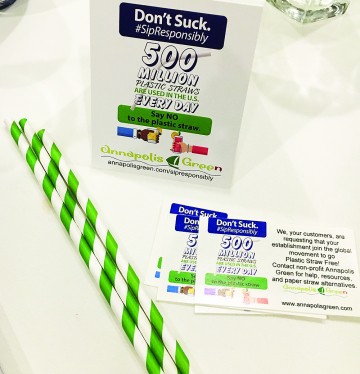The Last Straw
In my other life, I’m a server in an Annapolis restaurant. Like most American eateries, my restaurant serves straws with each drink, sometimes paired with a cocktail stirrer or two.
As well as a server and a Bay Weekly staff writer, I’m an environmentalist. The waste bothered me. Ever since my very first serving shift in 2014, I’ve been asking customers if they want straws with their drinks. I can cut a lot of waste this way. But many guests still prefer to drink from a straw.
Some customers tell me hygiene is the reason. Do straws really make a hygienic difference? Unless your server handles the rim of your glass, a straw doesn’t do much to keep you safe.
But it does do a whole lot to endanger marine creatures.
Straws: From Luxury to Deadly
Drinking straws have been around for thousands of years. The earliest straws, made from gold and wood, were created over 5,000 years ago. Rye grass straws were used in the early 1800s, but their fragile structure didn’t last. In 1888, while drinking a mint julep, Marvin Stone imagined and created the first paper straw.
In the 1960s, mass production of plastic allowed straws to be made quickly and inexpensively. Easy and disposable, straws trended. We have now become accustomed to sucking our drinks through straws.
Until recently, that didn’t seem a dangerous habit.
Now we know that it is.
Five hundred million straws are discarded every day in the United States alone.
A byproduct of petroleum, plastic straws are not recyclable. Millions make their way to our waterways, where they never break down but degrade into micro-plastics that persist in the environment eternally. That’s the problem with all plastics: They hang around, fooling oceanic animals into thinking them food. Ingesting plastic cuts a creature’s life expectancy in half. By 2050, there will be more plastic in our oceans than fish.
Straws have become one of the five dominant plastic pollutants in oceans over the past three years.
This tiny cylinder is becoming a deadly problem.
In the summer of 2015, a team of scientists doing research off the coast of Costa Rica found an injured sea turtle. The reptile had trouble breathing because of a foreign object lodged in one nostril. After the team extracted several centimeters of the obstruction, they saw it was a plastic straw.
They filmed the horrific scene to raise awareness about the growing oceanic plastic pollution.
More than 21 million people have watched this poor turtle’s struggle. He has become the poster child for the straw-free movement rising up globally.
Chesapeake Country’s Campaign
Thanks in part to that turtle, Chesapeake Country is part of a rising tide of concern.
Annapolis took a stand against plastic pollution this February during Restaurant Week. Ten restaurants pledged to go straw-free to support Annapolis Green’s Don’t Suck, Sip Responsibly campaign.
Annapolis Green, a local organization dedicated to connecting the community through environmental discussion and action, kicked off the restaurant ban with a jam-packed Green Drinks gathering of eco-minded people discussing the plastic problem over straw-free cocktails.
“We were alerted by Sailors for Sea. When we researched it, we found that plastic straws are the top item in every shoreline cleanup in the world,” said Elvia Thompson, co-founder of Annapolis Green.
Bartenders, servers and managers took cards to distribute to guests asking for straws. Some businesses agreed to use paper and reusable metal straws as alternatives.
Since Restaurant Week, several Annapolis restaurants — including Galway Bay, Preserve and Luna Blu — have kept the campaign going.
Luna Blu owner Erin Dryden says she now plans to use only biodegradable straws.

Preserve just unveiled seasonal drinks with a surprising twist. “Our new spring cocktails are a big hit already,” manager Michelle Hoffman wrote on social media. “But we bet there’s one thing you didn’t notice about them! None of them have straws!”
Now fully committed to the campaign, Preserve has a new policy regarding straws. Only paper straws are served, and only on request. The Main Street restaurant notes that even though paper straws are more expensive, the cost over time is less because fewer are used.
“Annapolis Green’s Don’t Suck #SipResponsibly campaign aims to help keep the Chesapeake Bay free of needless plastic pollution by making a tiny but meaningful change,” Hoffman said.
Turning the Tide
Cities nationwide are battling the overwhelming pollution with straw bans. In Malibu, California, 65 coastal businesses have until June 1 to adjust to a new no-straw policy. The California beach town hopes other cities will follow that example.
More than 200 businesses in Washington State have signed on to stop using plastic straws and utensils in a campaign named Strawless in Seattle. Miami Beach hotels can no longer serve straws without facing fines.
This transformation is global.
Scotland has proposed stern legislation to phase out straws by 2019, and Taiwan has the same goal set for 2030.
Just Say No
Taking action against straws on an individual level can make a difference, too. Simply saying no to straws is a great way to reduce plastic waste. Remember to say no straw when you order; once a straw has been served, it’s too late.
If you worry about germs on glassware, bring a reusable straw with you. Or ask your server if paper straws are an option. Reaching out to local businesses by asking them to only serve straws upon request helps restaurants see the momentum for straw-less serving.
As for me, I’ll refuse straws when I’m drinking and continue my quiet campaign on the job.
Save
